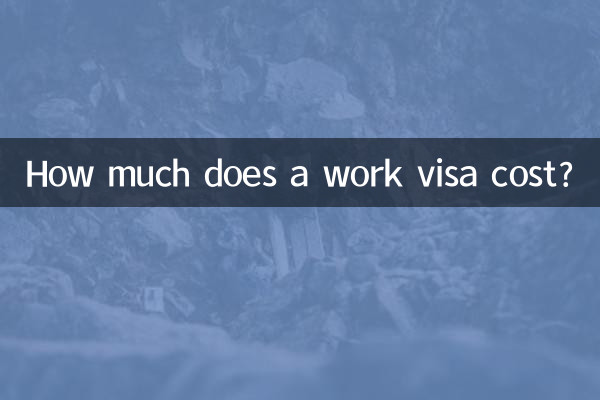How much does a work visa cost?
In recent years, with the acceleration of globalization, more and more people choose to work abroad. The cost of a work visa is a major concern for many people. This article will combine the hot topics on the Internet in the past 10 days to provide you with a detailed analysis of the fees and related policies of work visas in different countries to help you better plan your work abroad plan.
1. Comparison of work visa fees in popular countries

The following is a recent structured data comparison of work visa fees in popular countries:
| nation | Visa type | Fee (RMB) | Validity period |
|---|---|---|---|
| USA | H-1B work visa | About 15,000-20,000 | 3 years (can be extended) |
| Canada | temporary work visa | About 5,000-8,000 | 1-2 years |
| Australia | 482 Temporary Skill Shortage Visa | About 7,000-10,000 | 2-4 years |
| U.K. | Skilled Worker Visa | About 9,000-12,000 | 5 years |
| Japan | Technology·Humanities Knowledge·International Business Visa | About 3,000-5,000 | 1-5 years |
2. Factors affecting work visa fees
The cost of a work visa is not fixed and may fluctuate due to the following factors:
1.Visa type: The fees for visa types vary greatly from country to country for different occupations and skill levels. For example, the U.S. H-1B visa is aimed at high-tech talents and has a higher fee; while the seasonal work visa fee is relatively low.
2.Application location: In some countries, applying through different embassies or consulates may incur additional service fees or expedited fees.
3.Additional charges: Many countries will charge additional fees for health examinations, background checks, translation certification, etc. These fees may be as high as 50% of the main application fee.
4.exchange rate fluctuations: Since visa fees are usually calculated in foreign currency, exchange rate changes will directly affect the final RMB expenditure.
3. Recent hot topics and policy changes
1.Canadian work visa policy relaxed: Canada recently announced that it will expand the temporary foreign worker program, lower the threshold for work visa applications for some occupations, and reduce fees.
2.Australian visa fees rising: From July 2023, the main application fee for Australia’s 482 visa will increase by 3.5%, which is the smallest adjustment in recent years.
3.UK launches "high potential individual visa": A work visa for graduates from the world's top universities, the cost is about 20% lower than the traditional skilled worker visa.
4.U.S. H-1B electronic registration fee dispute: There are recent reports that the United States may increase H-1B electronic registration fees, which has triggered widespread discussion among applicants.
4. How to save work visa fees
1.Plan ahead: Prepare application materials as early as possible to avoid expedited fees. For example, the U.S. H-1B expedited processing fee is as high as approximately 3,000 yuan.
2.Pay attention to preferential policies: Some countries offer visa fee waivers for specific industries or regions. For example, some provinces in Canada have special immigration projects that provide cost subsidies.
3.Take advantage of free consultations: Many countries’ embassies and consulates provide free visa consultation services, which can help you avoid unnecessary expenses.
4.Compare agency service fees: If you need to go through an intermediary, it is recommended to compare the service content and fees of 3-5 institutions and choose the most cost-effective service.
5. Forecast of future trends
According to recent immigration policy trends in various countries, it is expected that the cost of work visas will show the following trends in the future:
1.High-tech talent visa fees tend to stabilize: In order to attract high-end talents, the increase in visa fees may slow down.
2.Seasonal work visa fees may rise: Affected by labor shortage, some countries may adjust the number of applications by increasing fees.
3.Electronic application reduces some costs: As more countries adopt online application systems, some administrative costs are expected to decrease.
4.Regional differences increase: Different countries or regions may adjust visa fees according to their own labor market needs, resulting in a widening gap.
In summary, work visa costs vary by country, type and personal circumstances. It is recommended that applicants fully understand the latest policies of the target country and consult a professional immigration consultant before making a decision to ensure they obtain the most accurate information and the most economical application plan. As the flow of global talent accelerates, work visa policies will continue to change, and it is important to stay tuned to the latest developments.

check the details

check the details